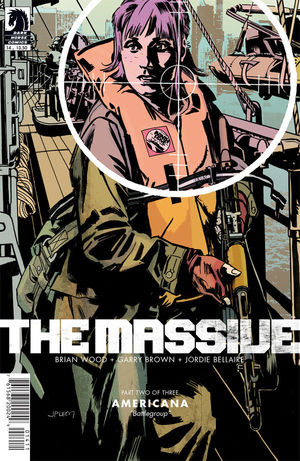The Massive #14 Review
By Zak Edwards
July 26, 2013 - 21:07
Dark Horse Comics
Writer(s): Brian Wood
Penciller(s): Gary Brown
Colourist(s): Jordie Bellaire
Letterer(s): Jared K. Flethcher
Cover Artist(s): J.P. Leon
$3.50 US
Brian Wood’s return to New York in The Massive is significant, not only in terms of plot and the story, but also in terms of thematics relating to his previous work. It’s no secret that DMZ, Wood’s love letter to the city, is strongly tied to this series and the shift happening aboard the Kapital is certainly indicative of the past coming back to haunt the present. Sure, Matty Roth isn’t making a cameo anytime soon, but DMZ’s New York is, in many ways, still present in Wood’s story here, albeit underwater and less densely populated.
 |
Garry Brown’s art continues to shine, and Jordie Bellaire’s colours are only helping. The differentiation of time, which plays into the issue’s concerns over the past and future, the drawing of history into a formulation of moving forward. The heavy palettes to differentiate between periods is an immediate visual clue, but Brown’s style works across these massive shifts exceptionally well, partly because of his light approach, but also because of his stark panelling choices. Most pages in the present use a larger picture as a backdrop, with panels laid on top, unifying the page into a sort of singular moment that is simply great to look at. But the flashbacks use heavy blacks and whites, throwing the background effect away to create stronger individual moments over a bleeding of time. The effect, like I said, looks great and keeps the pages focused on what matters: the setting, an especially important aspect to consider in a book about environmental collapse.
Grade: 8.5/10 Still one of the best books on the shelves, decidedly unique in a genre filled with exhaustion.
Related Articles:
The 2014 Top Shelf Massive $3 Sale Launched
Fantagraphics Books Announces "Massive" Gay Manga
The Massive #15 Review
The Massive #14 Review
The Massive #13 Review
The Massive #12 Review
The Massive #11 Review
The Massive #10 Review
The Massive #9 Review
The Massive #9 Advance Review
